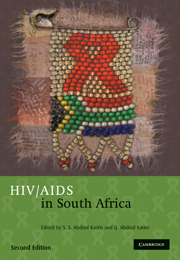Book contents
- Frontmatter
- Contents
- List of Contributors
- Foreword: Peter Piot
- Foreword: Nelson R Mandela
- Acknowledgements
- Section 1 Birth of a rapidly growing epidemic
- Section 2 The virus, the human host and their interactions
- Section 3 HIV risk factors and prevention strategiess
- 9 Reducing sexual risk behaviours: theory and research, successes and challenges
- 10 Barrier methods
- 11 Mother-to-child transmission (MTCT) of HIV-1
- 12 Sexually transmitted infections
- 13 Safe blood supplies
- 14 Intravenous drug use in South Africa
- 15 Positive prevention interventions
- 16 New prevention strategies under development and investigation
- Section 4 Focal groups for understanding the HIV epidemic
- Section 5 The impact of AIDS
- Section 6 Treating HIV
- Section 7 What does the future hold?
- Index
16 - New prevention strategies under development and investigation
Published online by Cambridge University Press: 07 September 2011
- Frontmatter
- Contents
- List of Contributors
- Foreword: Peter Piot
- Foreword: Nelson R Mandela
- Acknowledgements
- Section 1 Birth of a rapidly growing epidemic
- Section 2 The virus, the human host and their interactions
- Section 3 HIV risk factors and prevention strategiess
- 9 Reducing sexual risk behaviours: theory and research, successes and challenges
- 10 Barrier methods
- 11 Mother-to-child transmission (MTCT) of HIV-1
- 12 Sexually transmitted infections
- 13 Safe blood supplies
- 14 Intravenous drug use in South Africa
- 15 Positive prevention interventions
- 16 New prevention strategies under development and investigation
- Section 4 Focal groups for understanding the HIV epidemic
- Section 5 The impact of AIDS
- Section 6 Treating HIV
- Section 7 What does the future hold?
- Index
Summary
NO SINGLE STRATEGY OR TECHNOLOGY will be able to solve the AIDS pandemic. Rather, a host of prevention strategies such as behaviour change, voluntary counselling and testing, STI diagnosis and treatment, widespread access to male and female condoms, antiretroviral therapy, positive prevention as well as enhanced technologies like vaccines and microbicides will be required.
There have been significant advances in aids vaccine research including the identification of anti-hiv antibodies with broadly neutralising potential. The recent results from a vaccine trial conducted in Thailand has injected new enthusiasm into this field, which has suffered several setbacks in the past. An aids vaccine remains an important hope for the control of hiv/aids, but its realisation is still several years away.
Likewise, substantial progress has been made in the microbicide development field. Despite the disappointing results of the phase iii trials of cellulose sulphate, carraguard, and pro 2000, there is still much hope that a safe and effective antiretroviral microbicide is possible. Microbicides provide real potential to influence the course of the hiv epidemic and are likely to be available and accessible sooner than hiv vaccines and fill an important gap for womencontrolled prevention methods. Even after a safe and effective vaccine is discovered, vaccines and microbicides will have different but complementary approaches towards a global hiv prevention strategy with the same urgent objective, i.e. abating the global hiv pandemic.
- Type
- Chapter
- Information
- HIV/AIDS in South Africa , pp. 268 - 282Publisher: Cambridge University PressPrint publication year: 2010
- 2
- Cited by



